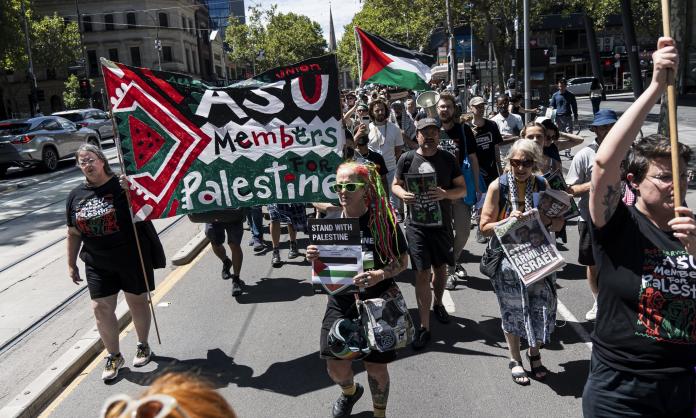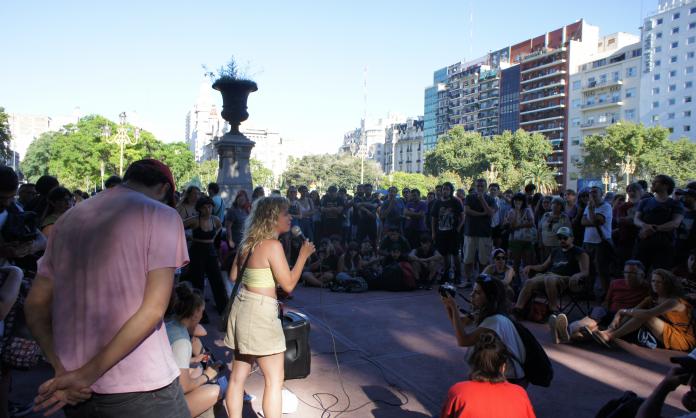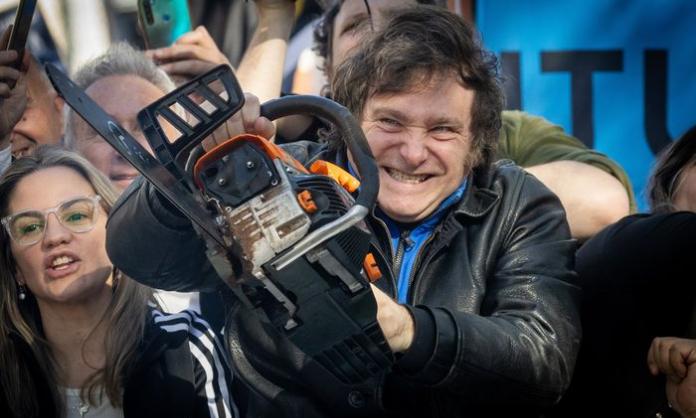Striking workers and supportive students at the University of Sydney shut down the campus with a 48-hour strike, called by the National Tertiary Education Union (NTEU), on 11 and 12 May.
Staff and students stood across seven entrances to the Camperdown main campus, ready to convince anyone who tried to enter why they should support the strike. The nearby Business School and the Conservatorium of Music had their own pickets—staff and students played instruments while holding the line at the Conservatorium.
Rain belted down for the duration of the strike: the picketers were drenched. But you never would have guessed it from their energetic defence of the campus. The picket was rife with spontaneous speeches, chants and songs
A union meeting of 350 staff voted in April for rolling strike action. It came in the wake of large-scale funding and staff cuts implemented by the university during the pandemic, with the threat of more cuts still looming. The key demands of the strike campaign are for a pay increase to keep up with the soaring cost of living, conversion to permanency for casual staff, no forced redundancies, the preservation of existing workload divisions that allow for both teaching and research, and enforceable targets for employment of Aboriginal and Torres Strait Islander workers.
Many students joined the strike. Deaglan Godwin, education officer for the University of Sydney Students’ Representative Council, told Red Flag that most students “understand the connection between the deterioration of our education and the attacks on staff working conditions”. He said that in the lead up to the strike, student activists passed motions endorsing it in more than 80 classes.
University of Sydney Vice-Chancellor Mark Scott said that he was “disappointed” by the decision to strike. A statement by the university lamented that staff had decided to “prematurely pursue this unnecessary action”.
But Nick Riemer, a senior lecturer and the NTEU branch president, told Red Flag:
“We’ve been negotiating since August. We’ve made no secret of what our members want. They [management] have had ample opportunity to accept even some of our most basic demands in principle. In a recent negotiation meeting they told us they weren’t even interested in talking to us about some of our demands.”
The university has suggested that it cannot avoid cuts or offer pay rises because of a revenue shortfall. But the university reported a surplus of $106.6 million at the end of 2020.
“They keep building new buildings, and at the same time they keep making cuts. So what’s more important? Good teaching, or shiny new buildings?”, one professional staff member pointed out during the strike.
“I’ve worked here for 31 years. Everyone has gotten more disgruntled. The workloads have increased, not just for academics but also for professional staff. I’m striking because I’d like to see us get a pay rise. I don’t think that’s greedy, I’d like our pay to at least keep up with inflation. I’m also striking because I believe that the academics need to be able to do their research, and their workload is preventing them from being able to do that.”
Mark Scott receives a base salary of $840,000. When bonuses are added, he “earns” more than $1 million a year. Meanwhile, many staff are paid a pittance.
“I’m being paid less per hour for the work I’m doing now than I was as a casual academic 35 years ago because of the number of hours I have to work for which I’m not paid”, one casual tutor told Red Flag.
“The fact that we have fellow tutors actually running tutorials today, while we’re all out on strike, is appalling”, they continued. “The fact that I’m now a colleague of a bunch of scabs is really upsetting.”
Picketing started at 7am each day. Staff and students began turning back cars and trucks that were trying to enter in the early hours of the morning. One of the picket lines started to keep a “BMW tally”—at least ten were turned away, along with a series of Mercedes-Benzes.
Some students who came to campus intending to go to class decided to join in the picket instead. One of these was a young engineering student who stuck around for hours, joining in the chants and old union songs.
“I’ve been on picket lines a lot over the past forty years, and I have to say that this one is the most joyous, and also the most politically charged and effective that I’ve ever seen”, the casual tutor commented. “The fact that people are actually constructing physical barricades today—I mean it’s got to be a first. It makes me want to stage a production of Les Mis!”
Senior lecturer Nikki Wedgwood told Red Flag that the two days she spent on the picket line were “exhilarating and empowering”. “The camaraderie and solidarity with staff, students and supporters was priceless and made the exhaustion, loss of pay and standing in the rain more than worthwhile. The experience was priceless”, she said.
University management put serious effort into organising scab labour. They moved some classes online, sent emails to students insisting that they had to turn up to their in-person classes, and sent out repeated statements downplaying the strike. They put out a call for alumni to attend a function on campus and held a student ambassador event. The management team of the Centre for English Teaching used casual staff for the two days of the strike because of the wide participation by staff from the centre.
A debate emerged on the picket line about whether to block the scabs who were trying to push their way onto campus. The hard pickets were important. If a precedent were set that scabs won’t be stopped from undermining industrial action, then the bosses would be capable of mustering more people to break strikes. It would weaken the union’s ability to disrupt the running of the university and damage the confidence of those on strike.
“The more USyd staff that withdraw their labour and the more USyd students that do not attend university in solidarity with staff, the stronger the message we are sending to management about our enterprise bargaining claims”, Nikki Wedgwood explained to Red Flag following the strike. “The whole idea of the picket lines is to ensure staff and students do not go on campus during our strike, primarily by convincing people attempting to cross to turn back but, failing that, by making it difficult for them to enter campus (though that’s not always possible)”.
At the Ross Street entrance, car after car turned around when confronted by the staff and student picket on the second day of the strike. Those on foot had to walk away, some after trying (and failing) to barge through. After about four hours of this, a mass of cops swelled to break the picket and let a car through.
“I went down our line of colleagues and members and made sure everyone understood that continuing to stand across the road with arms linked, as we were, could mean getting charged (physically) by the police and getting knocked to the ground”, Nick Riemer recounted in a Facebook post.
“Without exception every one of my fantastic colleagues—not activists or militants, just staunch researchers and lecturers and professional staff with principles, who know what side they’re on—stood their ground.”
This gave resolve to everyone on the picket. Afterwards, as rain bucketed down, chemistry lecturer Ron Clark unpacked his French horn and set up a music stand, sheltered by a few umbrellas. Clark had spent the day touring the picket handing out songbooks and leading renditions of songs of the workers’ movement including “The Internationale” and “The Red Flag”.
At the Victoria Park entrance, a casual researcher who had been nervous at the start of the strike gave a spontaneous speech about how he now felt confident and inspired by the energy and militancy of the picket, which had turned away every jostling scab and aggressive motorist who approached it.
Fred, a retired construction worker, turned up to the strike with his granddaughter in her primary school uniform. He brought her to see the picket line on the way to school, because, as he explained to Red Flag, “everyone should know what they look like”. He explained to her why strikers were blocking cars, what scabs are and why they need to be stopped. Then he carried her on his back to join in.
“We will keep shutting down the university and disrupting business as usual until management meets our demands”, Alma Torlakovic, a socialist and staff member on the NTEU branch committee, told Red Flag. “We will also keep picketing the university and making the point that if you work here and you support our cause the only way to show solidarity is to refuse work on a strike day.
“Our pickets are asking people: whose side are you on? Are you on the side of management, who want to cut our wages and make it easier to sack us? Or are you on the side of those who are sticking their necks out to improve pay and conditions for all of us?”
University of Sydney staff will be striking again on 24 May.











